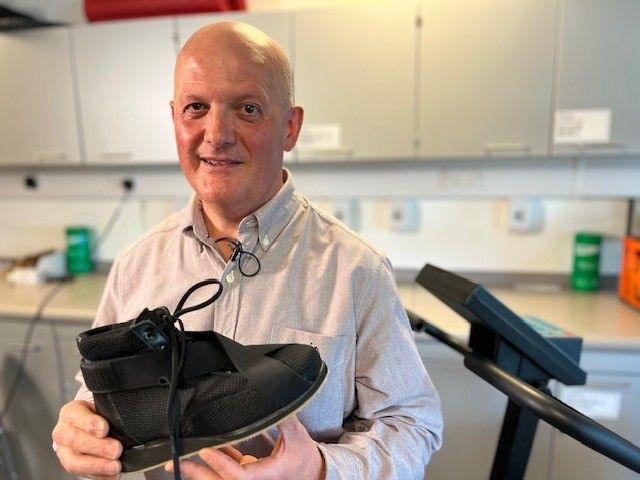It's just a pair of shoes - but they're life-changing for me
Jeanette Russell, who suffers from foot drop caused by her MS, says the new shoes have changed her life
- Published
Jeanette Russell has never been more delighted with a new pair of shoes.
They were created by a skilled designer but they are not the latest in high-end fashion.
The shoes have been specially designed to stop Jeanette falling over - and they are life-changing.
The black boot-like creations are for people like Jeanette who suffer from foot drop, a condition caused by her MS that makes it difficult for her to walk unaided without tripping or falling over.

The shoe uses a Velcro system to support and stimulate specific areas affected by drop foot
"I just put the boots on and I can drive, I can do the gym I can go hill-walking," says Jeanette.
"I can walk over terrain that is really rough and can walk normally down the street with confidence and strides, when before I had a rolling gait which gave me a really sore back.
"I haven't had any falls since I've been wearing the shoes."
Foot drop, which is also known as drop foot, affects many people who have conditions affecting the nervous system, like MS or cerebral palsy, or people who have had a stroke.
They struggle to keep their toes lifted, making walking difficult and tiring. As a result, they are more likely to fall.
Now researchers at Queen Margaret University (QMU) in Edinburgh have invented a shoe which they hope will tackle this problem by providing the right kind of support to the foot, keeping the wearer upright and safer.

Prof Derek Santos said an adjustment of the elastic could be made to suit different issues with the foot
Prof Derek Santos is one of the QMU researchers who designed the shoe.
He says the concept is quite simple but very effective. The use of adjustable Velcro straps helps the shoe to fit each user and support at the ankle.
"You can adjust the elastic depending on your disability," he said.
"If you have a weaker muscle or a totally paralysed muscle you can actually activate the elastic to compensate for these things.
"You can also tighten the elastic more on one side than the other.
"If you have a foot that inverts, sometimes people tend to trip over, so the boot will actually put your foot in a much better position by simply adjusting the tension in the elastics."
The research team believe the new footwear could improve the wearer's walking and prevent hundreds of thousands of falls in the UK.
But as it is a global problem, Dr Kavi Jagadamma, senior lecturer at QMU, says they want to help people around the world and adapt the shoe to individual needs.
"We are particularly interested in developing simple designs like sandals where this could be integrated for people in hot countries or people living in low income countries, where people can't afford expensive boots," he said.
"The simple sandals might be more accessible and also culturally more normal to wear. So that's our ambition going forward."
Professor of physiotherapy Cathy Bulley is also part of the QMU research team. She says the fact that it looks like a normal piece of clothing is a big advantage.
"We felt we needed another option for people that was more comfortable to wear, easier to put on and generally that people are more likely to keep using.
"We've been working on the clever but low-tech solution."
Jeanette, a former army nurse, says her physical confidence has been restored by the shoe. She has even been able to return to the challenging hill-walks she loves.
"I'm looking forward to getting a hiking boot in this design so I can get up Ben Nevis.
"I'm also hoping to be marching past the cenotaph this November, with pride in my boots. "
What causes foot drop?
Foot drop - or drop foot - usually affects one foot and can have an impact on a person's ability to walk.
It can be a temporary condition that may get better on its own or with treatment, but for some people the condition is permanent.
It can be caused by damage to a nerve that runs down the leg making it difficult to lift or move the foot and toes, often from a sports injury, slipped disc in the spine, lack of movement, or nerve problems caused by diabetes.
According to the NHS, external, less common causes of foot drop include:
inherited conditions like Charcot-Marie-Tooth disease
muscle weakness caused by muscular dystrophy, spinal muscular atrophy or motor neurone disease
damage to the brain or spinal cord caused by a stroke, cerebral palsy, Parkinson's disease or multiple sclerosis
Related topics
- Published20 September 2012
- Published15 April 2024
